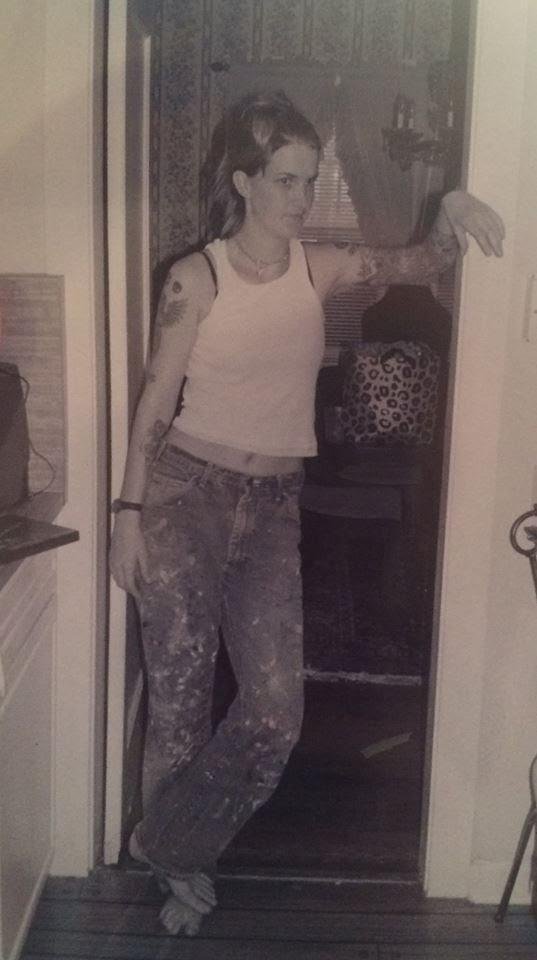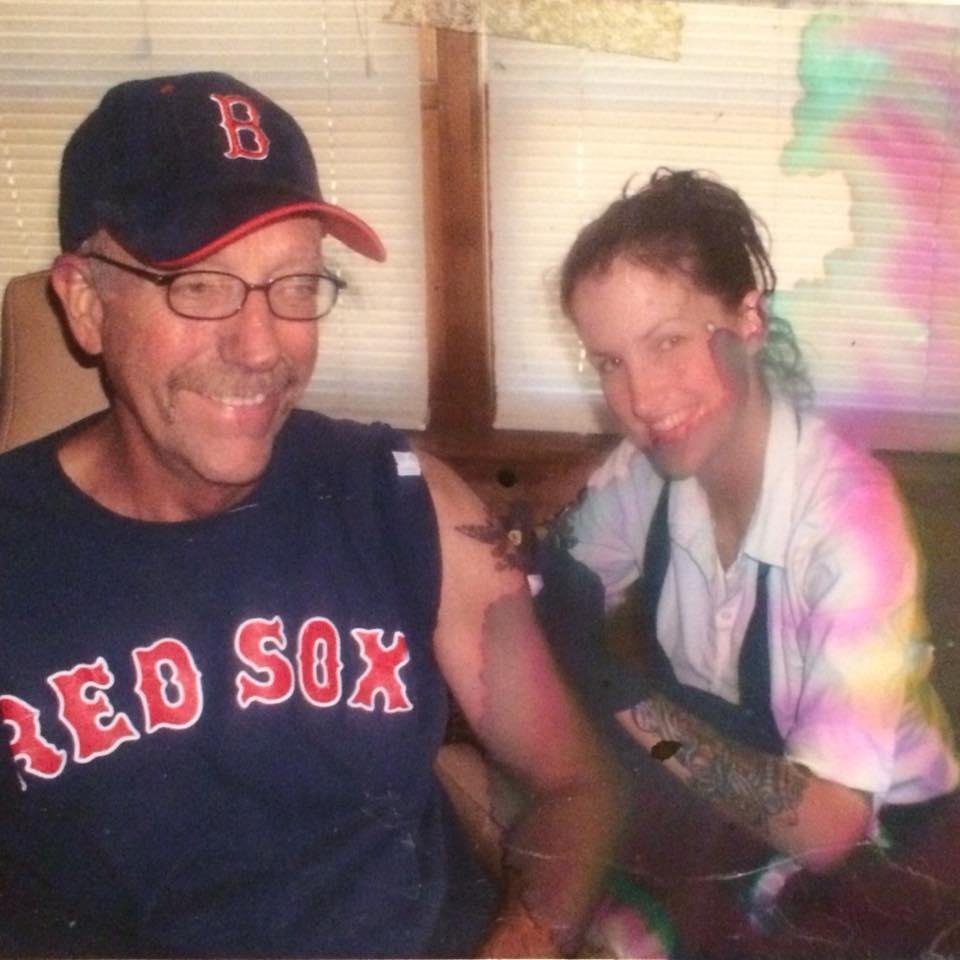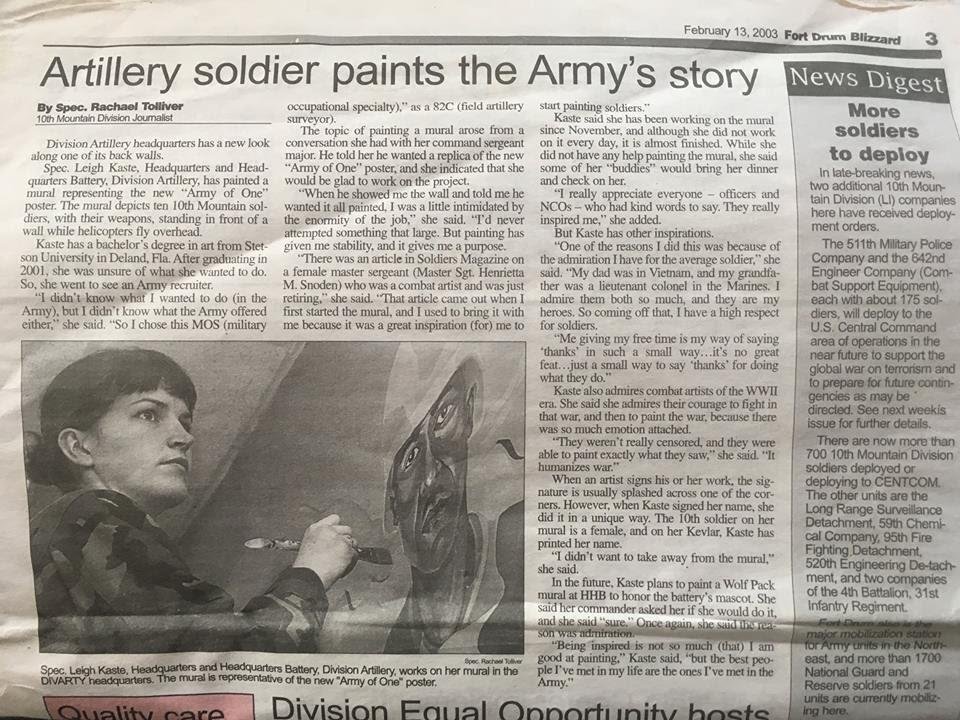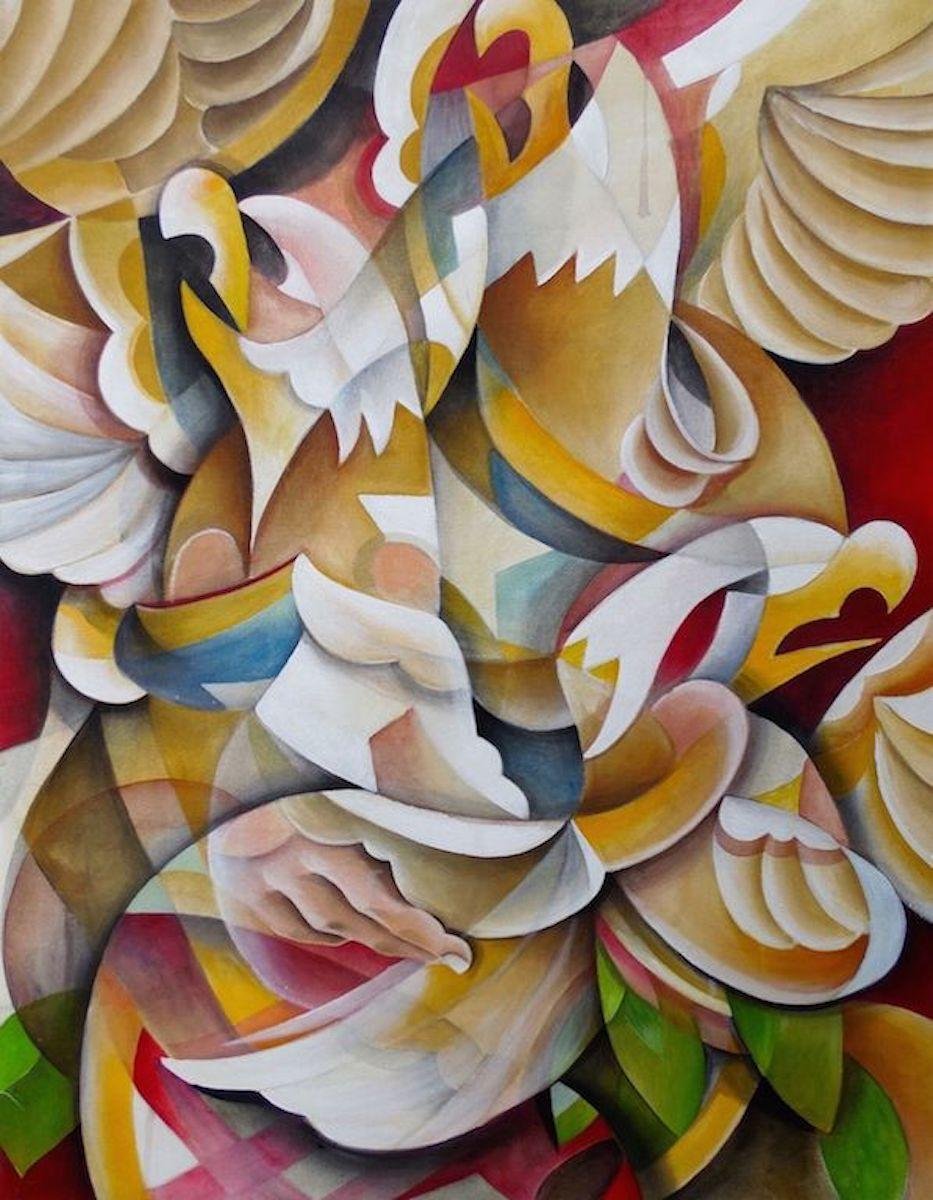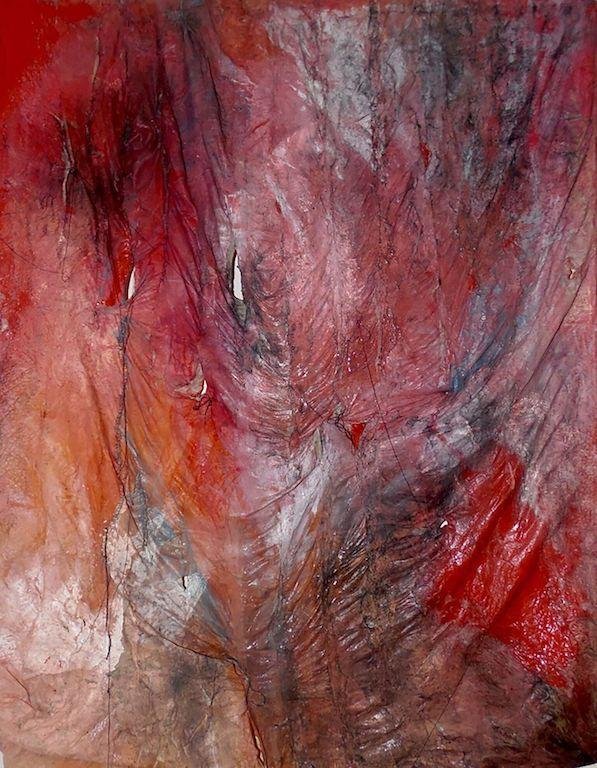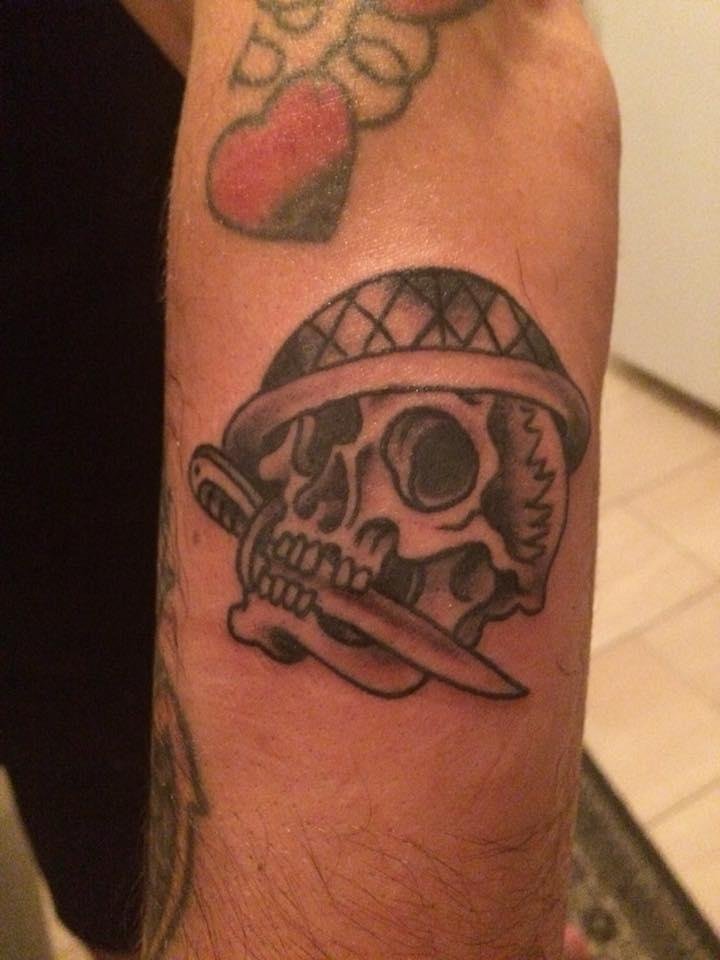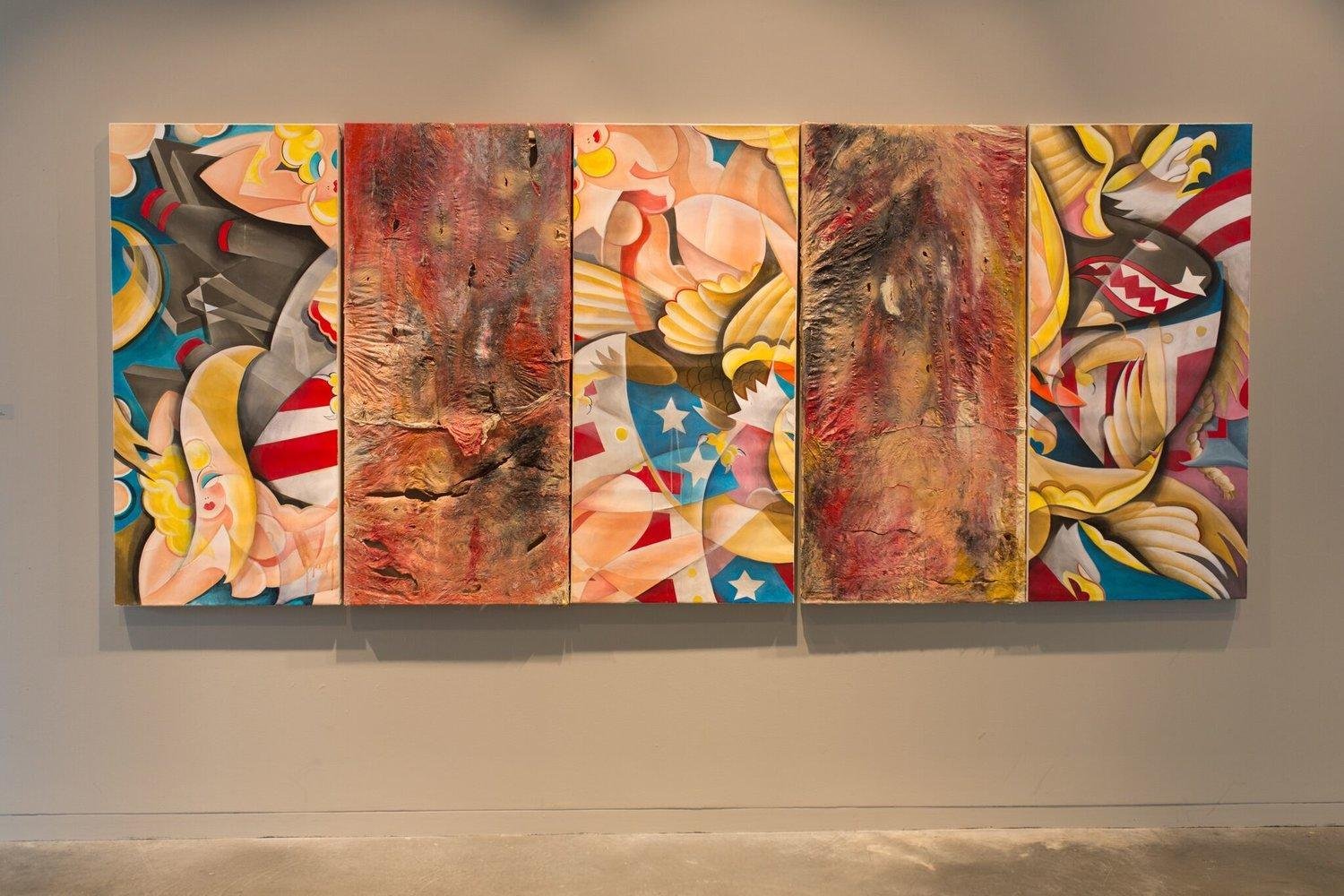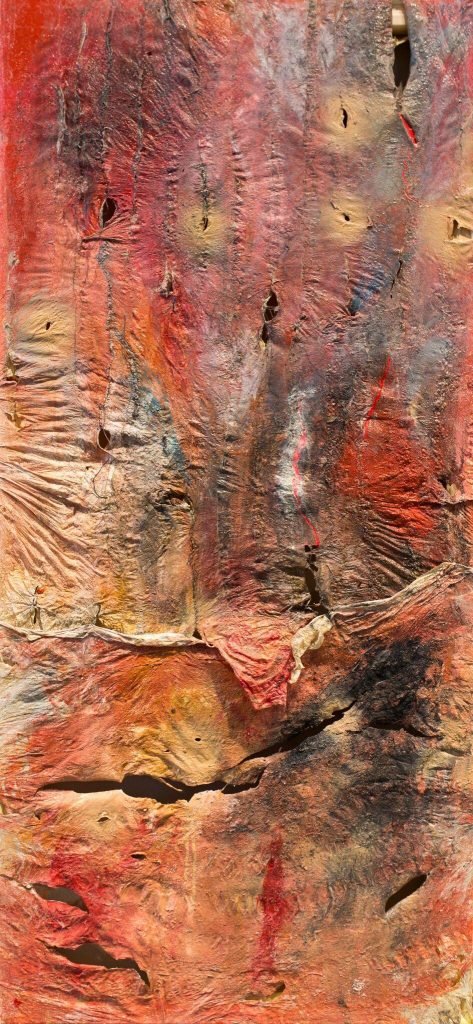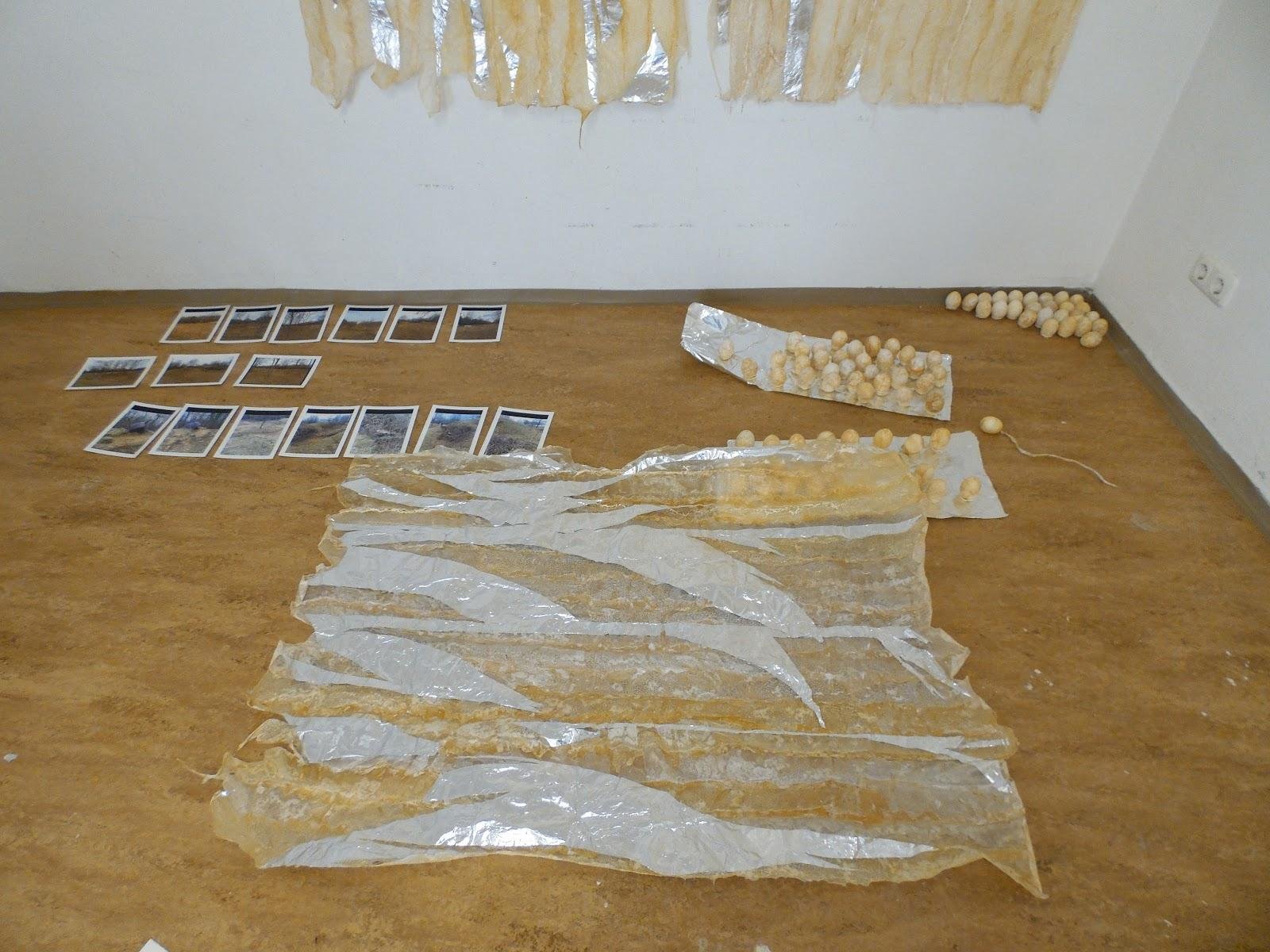An Interview with Leigh Cortez
Leigh Cortez is an art student-turned-artillery-soldier-turned-milspouse-and-tattoo-artist-turned-MFA-student-turned-artist. Her bold and compelling work is layered with autobiographical meaning. With her paintings, Leigh invites a dialogue both within the military community and with "outsiders" exploring modern military life, tradition, trauma, unpredictability, and belonging. Leigh's thoughtful descriptions of her work and process, as well as her candid story about the path she has taken, reveal her self-possessed, passionate, and deliberate character. She is indeed a maker, both of her artwork and of her own opportunities. Leigh's story and artistic purpose are another inspiring example of the rich determination that so many MilspoFAN artists possess. Without further delay, let's meet Leigh!
"It is necessary for you, you who now draw near to the motley and tempting realm of art, it is very necessary that you also comprehend how close to danger you are."-Max Beckmann, from Letters to a Woman Painter 1948
MilspoFAN: Tell us a little about yourself, your journey as a military spouse, and where you are today.
Leigh: Hello, my name is Leigh Cortez and I am an artist, painter, maker, tattooer, and Mom. Here is a quick history of why I paint what I do and why I mess around with cow intestines but don’t make sausage:
I joined the Army on September 7, 2001. Just as I was finishing my Bachelor Degree in Painting from Stetson University, also 4 days before 9/11. My Dad is a Vietnam Veteran who voluntarily served as a Combat Medic in the Army. I have always admired my Father’s service and that he volunteered, so when I considered joining the military, I walked directly to the local Army recruiting office and asked them to sign me up. They were thrilled.
Admittedly it was to pay back student loans I had accrued getting my undergrad. At the time I was young and single and my post-graduate plan was to pursue an artist lifestyle, move to NYC and try to live cheaply in a tiny place with a bunch of friends, ostensibly to try the whole ‘starving artist’ thing for a while and see what happened. However, I had a copious amount of student loans and couldn’t afford even that level of bohemian living! Being the art school stereotype, I was, I waltzed into the recruiter’s office with a ten-inch pink mohawk. Regardless of my hairstyle, the Army said they would pay back my loans if I enlisted for three years. I signed that day and cut off the hawk.
I think this was taken very soon before I went to the recruiter’s office. My mohawk is there but not styled ‘up’, so it just kind of lays there. I have ‘paint pants’ on…. which have always been a staple in my wardrobe!
Me tattooing my Dad, a traditional military tattoo with his unit he served with in Vietnam on it
(I think this was taken very soon before I went to the recruiter’s office. My mohawk is there but not styled ‘up’, so it just kind of lays there. I have ‘paint pants’ on…. which have always been a staple in my wardrobe!)
Four days later I knew my plan would entail much more than originally anticipated. I wasn’t regretful of my decision, I just knew things had changed.
I served with 10th Mountain Division at Fort Drum as an Artillery Surveyor (which the recruiters told me had a lot to do with drawing, not at all true). During my years in the Army I didn’t pursue much personal art work, and everything I had done during my undergrad seemed very far away as did NYC, although Fort Drum put me geographically closer to it. However, my chain of command did discover that I had an art degree and I quickly became the unofficial resident artist for DIVARTY (Division Artillery). I painted mostly unit murals, my largest being a painting of the Army of One poster popular at that time, ‘commissioned’ by the DIVARTY Command Sergeant Major. It pictured 11 soldiers’ side by side that I painted larger than life versions of down an entire wall at DIVARTY Headquarters. I became quite efficient at painting camo!
A pic of the write up I got in the Fort Drum post newspaper for the huge DIVARTY mural I did
At Fort Drum I met who would become my husband, then a Forward Observer. We decided to get married and talked about having a family. I left the Army as he wanted to stay in, it made sense because he had always wanted to be a soldier, and was a much better one than I! Also, there was still a desire in me to go back to art, as I felt there was something unfinished and I needed to search it out again. I went back to painting, built onto work I had left before the Army and amassed another portfolio.
Since my undergrad days I had also been very interested in tattoo, this led to finding a tattoo apprenticeship I did for about a year. After the apprenticeship, I tattooed professionally for 11 years, working in shops in towns everywhere we PCS’d too. It enabled me to work with amazing tattoo artists and I enjoyed many things about the trade. One aspect, due to working in military towns outside of the bases we were stationed at, was that a lot of my clientele were military. The military and tattoo have a long history, and the traditional military tattoo became a favorite subject of mine.
During those years, my husband deployed 4 times, we PCS’d many times, and had 3 awesome kids. As a career, tattooing worked with our mobile and unpredictable lifestyle, because as long as I had my portfolio I could find a job at a local shop. It also largely satisfied the need I had to make art, but eventually I wanted to make more art, and go back to painting. I decided to pursue an MFA and focus completely on painting. I attended the Low-Residency Master of Fine Art in Visual Arts Program at Lesley University College of Art and Design. It was an amazing experience and completely united me with what I had left behind years ago in undergrad, back to the studio and making art that was what I needed it to be.
Death or Glory, 2018 Panel 1: Acrylic on Canvas
Death or Glory, 2018 Panel 2: acrylic and pigment on stretched gutskin
MilspoFAN: Describe for us your creative work and the aesthetic of your art?
Leigh: Going back to school at Lesley University completely re-introduced me to art making. I was deeply entrenched in tattoo when I began grad school, and knew that visual language, which had demonstratively changed how I made art, even on non-living surfaces. My first year at Lesley I had to reexamine everything I knew about visual representation. It felt as if I was constantly dissecting imagery, language and personal experience in the studio, looking for what I could use both materialistically and conceptually to satisfy this discussion I felt needed to be presented. Personally, I hold experience as cornerstone to knowledge and I wanted to use what I knew from my life as a veteran, military spouse and tattooer to develop a visual space that can experientially open a discussion with the viewer. In a sense, I feel it is my responsibility as an artist to speak from these experiences, especially during the longest war in US history.
MilspoFAN: On your website, leighcortez.com/about, you write: “My work examines the unpredictability, tension and trauma of military life from personal experience as veteran and spouse of an active duty combat soldier. Taking inspiration from artists of postwar Material Realism as well as Cubism, I continue the dialogue of the relationship between destruction and creation, concerning the picture plane and the image.” Tell us more about the interplay of your life and artwork.
Leigh: My work currently is formalistically a mix of different styles and materials that are purposely derivative of past art movements that were a response to wartime experience, such as Cubism and Material Realism.
Using the images from my trade, I considered the imagery and symbolism of traditional military tattoos, how it functions and why that art became so prevalent in the military subculture, as well as how that imagery forms a military identity.
The linear aspect and specific style of traditional military tattoos is important to its recognizability as that style. I wondered what would happen if I interrupted that specific quality and disrupted its function as tattoo by repeating the image in overlapping layers and in a sense ‘exploding’ it on a surface. I was deconstructing a tattoo image into shapes, much like later cubist artists did, except I focused on tattoo imagery. What discussion of military tattoos could that provoke, if it stopped functioning as a tattoo and was presented as a painting?
MilspoFAN: From your website, leighcortez.com/about: “I work both with destroying images indicative of the military tattoo subculture and with material intrinsically associated with destruction, such as the intestines of animals traditionally used for sausage preparation. The visually contrasting bodies of work thematically unite in a new space causing contention and anxiety. A chaos of opposing styles and material disunity, the space is volatile and unsolved, an attempt to communicate the collateral of constant war in a society consistently unstable.” How did you discover gutskin as an artistic medium? When did you start using it?
Leigh: Simultaneously as I was exploring the semiotic functionality of tattoo imagery on canvas, I wanted to examine the visceral aspect of the tattooing practice. I started thinking about the process of manipulating a living surface with pictures and the concept of permanent inscription to a body. I experimented with various once-living surfaces, such as rawhide and velum. A colleague of mine from Lesley actually mentioned the radical idea of using sausage casing as material, in that it is a ‘live’ surface that could possibly be painted on. The intrinsic quality that using actual body parts in my art related to the process of tattoo, the act of making skin into image. This sparked lots of experimentation and odd encounters at the butcher store asking for large amounts of sausage casing, which is actually the encasing of cow or pig intestines used to make sausage. One butcher asked how my sausage was coming out as I had evidently been making quite a bit of it. I decided to tell him I was just an ‘art school weirdo’ and used it in art making. He never really asked anymore questions after that.
I eventually, after 6 months of trial and error (to include starting an intestine fire in my stove…), figured out a way to make a ‘paper’ out of the casing by cutting it, layering, and stretching it onto aluminum foil to dry. It can then be peeled off and makes a very interesting surface. That’s when the fun really began. The resiliency of the material is amazing and responds to wet material, such as watered down acrylic and ink, absorbing the water and pigment to make it pliable. Then it becomes completely unpredictable, in that I never know the final outcome until it completely dries again, about 24 hours later. There is an uncertainty about the material as the maker is completely left out of the final authority of its creation. I can fasten it to board or stretcher bars, but as it dries the material stretches into its own structure.
Babes and Beasts, 2017 Acrylic on stretched bovine casing
MilspoFAN: Tell us more about the interplay of your life and artwork.
Leigh: My artwork is a response to personal experience. Through using sausage casing as untraditional medium, as well as presenting that work next to more traditional medium, such as painted canvas, I have been able to express that experience in a visual space. The resilient, yet unpredictable surface of the casing paper spoke perfectly to my experience as a military spouse. It could be repeatedly painted, scrubbed, dried and still maintain a structure, but at the same time ultimately unpredictable and uncontrolled by the artist. I compared this to my experiences of military life, and the ability to maintain in whatever unpredictable situation we encounter.
The heavily materialistic importance of what I came to call ‘gutskin’ paper alluded to work of post WWII Material Realist artists who used the intrinsic nature of certain materials in their work to describe experience.
Eventually while working on these two bodies of work at the same time and knowing they had a derivative nature to their aesthetic, I considered how they functioned together, or how the visual disunity of their integration developed a new space that incorporated the acknowledgment of their historical influence. The presentation of these works together disrupts the singular interpretation of their historic representations and question the new space they encounter each other in. The space, experienced by the viewer, becomes a part of the art as it presents a new discussion; that which considers the effects of long-term war.
Till the Death, 2018
Detail: Till the Death (panel 2). Stretched gutskin. 2018
As I worked, it was interesting how themes started to connect and both bodies of work developed simultaneously as well as built on each other. I am still developing this work, with the intention of presenting it in spaces that provide an opportunity for the discussion to develop.
There’s an urgency to my art-making. Not necessarily to voice my subjective opinion that insists on interpretation, but to put something out there, to stir discussions and provoke thought. To ask so others can participate in the art making and collaborate together. The finality of the work happens where the viewer stands, and what they bring to it.
MilspoFAN: How has your role as a military veteran military spouse impacted your work as an artist- creatively, logistically, or otherwise?
Leigh: As mentioned, my work is a response to military life as I know it. It is examined and presented to create a dialogue in our community, and especially with the viewer in general. In as much as joining the military after undergrad may have taken me away from that initial plan of being an ‘artist in NYC’, it has cultivated my art. The experiences I had in the military, as a military spouse and tattooing the military community have given me perspective that is extremely special to me. As a small percentage of the population who serve or have served (1%), I have decided it’s important in my work to represent this perspective and welcome conversation with the 99% who are not directly affiliated.
Logistically my work is always impacted. It takes a while for me to build a studio space so frequent moving can make maintaining a studio very difficult, especially because my studio is always a complete wreck and needs to have a collection of materials. I build my own canvases or surfaces and make some of my own pigments so I also need tools etc. Right now, we live in Germany. Moving OCONNUS I had to get rid of a lot of material and hope the gutskin didn’t get seized by customs!
Studio working! Check out the BDU socks!
Picture from current studio of dried gutskin getting peeled from aluminum foil
Also establishing yourself in a new area as an artist, as with all other aspects of frequently moving, takes more effort. Sometimes I envy friends who have stability and so have cultivated a nice artistic niche. However, all of this works thematically into my art, and so actually adds to its development. Also, working in new areas and meeting new people has been extremely influential and I consider that one of the best parts of military life.
MilspoFAN: How do you meet other artists or plug into the local arts scene when you PCS?
Leigh: Social media is a huge part of how I stay connected with artists I know. When a PCS comes up, then I find out who I will be closest to and plug in from there. Then I also just hit the pavement, find out what the art scene is and go to events etc. There are amazing working artists everywhere I have been stationed and sometimes open studio spaces, where I have met many artists who are more than happy to show you around. Spend some time at local galleries! I also volunteer at local galleries to teach art classes, which can be a great way to meet local artists as well. Recently I have been teaching as an Adjunct Professor of Humanities for the University of Maryland University College program here on post. I absolutely love teaching art to the military community and have found great artists in students who did not even realize they were!
MilspoFAN: What’s next for you?
Leigh: Always: Looking at art, meeting new artists, making new art, more collaborating!!
I am still developing this current body of work and want to eventually expand it into an installation space. I am also working on showing individual pieces with a group of fellow artists in the States. We PCS back to the States summer 2019 so that will also dictate some of what comes next, as it always does!
Leigh, thank you so much for your amazing and inspiring story!
See more of what Leigh is creating by checking out her website and blog, and follow her on instagram at:
Inspired by Leigh’s work or have a burning question for her? Remember to comment here on the blog, or on Facebook in the MilspoFAN group or MilspoFAN page.
Not a MilspoFAN member yet? Just reach out! Request an add to the Facebook Group, message me from the MilspoFAN Facebook page, or contact me at milspofan.com/contact.
See you there!





